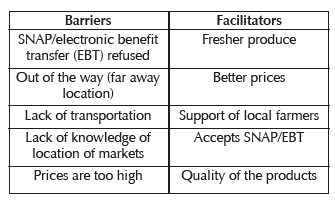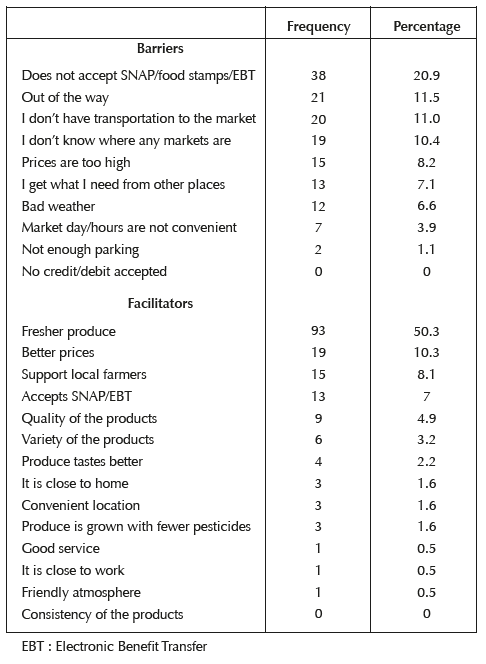Promotion of local farmers’ market as part of a healthy, sustainable food system
Farmers’ market shopping is an opportunity to enhance access to healthy foods, especially locally produced fresh foods. Farmers’ market shopping can also be a way to boost fruit and vegetable (F&V) consumption. This could positively affect overall diet quality, as greater consumption of F&V is thought to be linked to improved weight maintenance and low chronic disease risk.
The aim of this study was to evaluate the impact of farmers’ market shopping on fruit, vegetable, and sugary beverage consumption, as well as to examine barriers to and facilitators of farmers’ market shopping among low-income consumers.
Study design
Between April and July 2013, 205 adult Supplemental Nutrition Assistance Program (SNAP) participants were asked to complete a quantitative survey of their food purchases. Although the SNAP was conceived to fight hunger and to improve health conditions among low-income individuals in the United States, SNAP participants tend to have lower overall diet quality than their income-eligible non-SNAP participant counterparts. The study was set in Pitt County and conducted as a part of an evaluation of North Carolina’s Community Transformation Grant Project (NC CTG-Project) farmers’ market initiative. The purpose of this initiative was to increase farmer’s market use among North Carolina residents.
The quantitative survey included questions to assess: Farmers’ market shopping frequency; Awareness of markets; Access to markets; Barriers and facilitators to farmers’ market shopping; Dietary behaviors; Body Mass Index (BMI). Farmers’ market shopping frequency was investigated through questions about purchasing locally grown F&V from farmers’ market, community-supported agriculture, roadside stand or pick-your-own produce farm. An awareness score was established in function of knowledge of market locations.
To quantify the access to markets, they used a Google Application Programmable Interface, while barriers and facilitators were identified with a list of possible choices. Participants were also free to add additional barriers to farmers’ market use which were not on the list. F&V, sugary beverage consumption and fast-food consumption were measured to explore dietary behaviors. Finally the BMI was calculated from self-reported height and weight.
What kind of profile among SNAP participants?
Mean age and mean BMI were 37.5 years and 32.4 kg/m2 respectively. Three quarters of participants were black/African American, 84% were female and 56% had at least a high-school education. In the past 12 months, 43% reported having shopped at a farmer’s market or produce stand. Mean daily F&V consumption was 4.0 servings per day, with 4.7 and 3.6 servings per day respectively for those who ever versus never shop in farmers’ markets.
Table 1 : Barriers and facilitators of market’s shopping

The most frequently mentioned barrier was lack of SNAP/EBT being accepted at the market (Table 2). There was a positive relation between F&V consumption and farmers’ market shopping, suggesting that shopping at farmers’ markets is related to greater F&V consumption and possibly better overall diet quality.
Table 2: Barriers and facilitators of farmer’s market shopping among Supplemental Nutrition Program (SNAP) in eastern North Carolina, USA, April-July 2013

A step forward
By determining the barriers and facilitators, it was possible to identify how to promote “direct farm-to-consumer venues”.
More efforts should be taken to improve financial, social and geographical access to local farmers’ markets. This could have a positive impact on residents’ diet quality, and also improve local agricultural economies.
Based on: Jilcott Pitts SB, Wu Q, Demarest CL, Dixon CE, Dortche CJ, Bullock SL, McGuirt J, Ward R, Ammerman AS. Farmers’ market shopping and dietary behaviours among Supplemental Nutrition Assistance Program participants. Public Health Nutr. 2015 Sep;18(13):2407-14.
